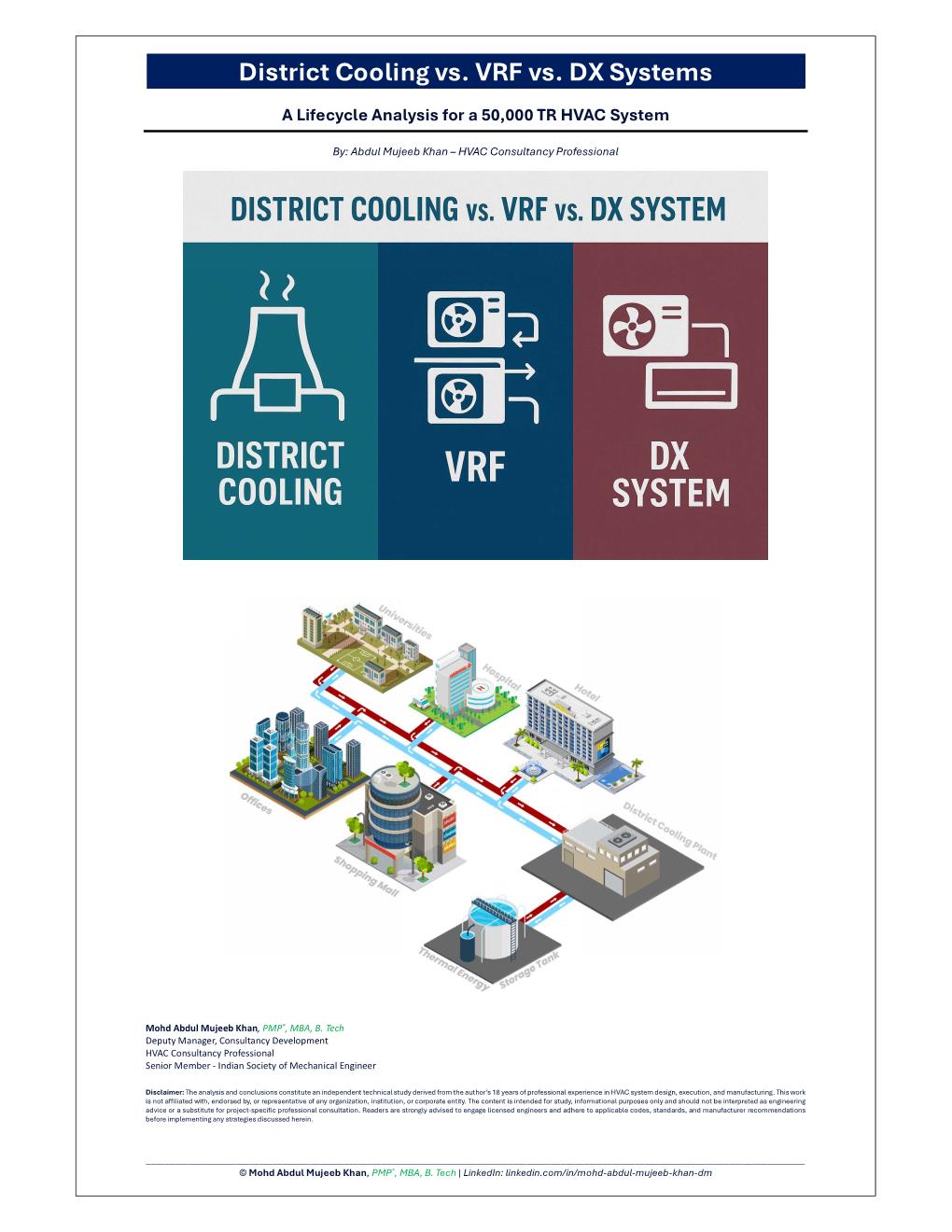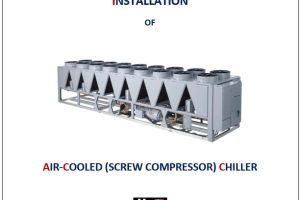District Cooling vs VRF vs DX Systems for Mega Developments – A Lifecycle Comparison

District Cooling vs VRF vs DX Systems for Mega Developments – A Lifecycle Comparison
Download full document : Link 👉 District Cooling vs VRF vs DX System LCA 👈
Disclaimer: The analysis and conclusions constitute an independent technical study derived from the author’s 18 years of professional experience in HVAC system design, execution, and manufacturing. This work is not affiliated with, endorsed by, or representative of any organization, institution, or corporate entity. The content is intended for study, informational purposes only and should not be interpreted as engineering advice or a substitute for project-specific professional consultation. Readers are strongly advised to engage licensed engineers and adhere to applicable codes, standards, and manufacturer recommendations before implementing any strategies discussed herein.
Cooling is no longer just about comfort, it is about sustainability, cost efficiency, and supporting global commitments to reducing carbon emission. For a project with a total cooling requirement of 50,000 TR, the choice of HVAC system can define not only the operational efficiency of the facility but also its environmental footprint over decades.
This article presents a comparative lifecycle analysis of three major cooling strategies:
District Cooling (DCP) is a highly efficient, centralized cooling system that produces chilled water in a central energy plant and distributes it through an insulated underground piping network to multiple buildings for air conditioning and process cooling needs, supplying chilled water to multiple buildings.
This system utilizes one or more large-scale, water-cooled chillers often equipped with energy-efficient turbocor or magnetic centrifugal compressors and optimized for partial-load performance to generate chilled water at typical temperatures of 4–7°C (39–45°F).
The chilled water is circulated to individual buildings where it passes through heat exchangers or cooling coils to absorb heat from the spaces, before returning warm (e.g., 12–14°C) to the central plant to be rechilled. Key advantages include significant energy savings (30–50% compared to decentralized systems), reduced greenhouse gas emissions, lower maintenance costs, and freed-up building space that would otherwise house individual chillers and cooling towers.
District cooling supports sustainability goals through economies of scale, the use of renewable energy integration, thermal energy storage (TES) options, and modern controls that adapt to dynamic cooling demands across residential, commercial, and industrial complexes.
Variable Refrigerant Flow (VRF) is a sophisticated and highly adaptable HVAC technology that utilizes refrigerant as the primary heat transfer medium to deliver exceptional zoned thermal comfort and energy efficiency across diverse building environments.
This innovative system architecture features a modular design in which a single outdoor condensing unit, often equipped with advanced inverter-driven compressors, is connected via precisely engineered refrigerant piping to an array of indoor fan coil or ducted units.
This configuration enables fully independent temperature control in individual zones or rooms, accommodating varying occupancy patterns and usage requirements without cross-contamination of air or thermal preferences.
In addition to their operational efficiency, VRF systems are celebrated for their design flexibility, minimal spatial requirements, and significantly reduced ductwork compared to conventional systems. These attributes make VRF an ideal solution for a wide spectrum of applications from commercial offices, hotels, and health care facilities to high-end residential and historic retrofits where architectural constraints, noise sensitivity, and energy performance are critical considerations.
Modern VRF systems also feature sophisticated onboard controls and connectivity interfaces, enabling seamless integration with building automation systems (BAS) or building management systems (BMS) for centralized monitoring, data analytics, fault detection, and preventive maintenance.
This smart functionality supports optimized system performance, improved lifecycle management, and alignment with contemporary sustainability goals, positioning VRF technology as a leading choice for future-ready HVAC solutions.
Direct Expansion (DX) systems are the most common type of air conditioning, where refrigerant is used directly to cool the air in the conditioned space.
In these systems, a refrigerant evaporator coil is located directly in the air stream that will be supplied to the room; as warm air passes over the cold coil, the refrigerant inside absorbs the heat and expands (changes state from liquid to vapor), thereby cooling the air efficiently. This fundamental process is facilitated by a matched outdoor unit housing a compressor and condenser coil, which rejects the absorbed heat to the outside atmosphere.
The term “split” system originates from this key separation between the indoor evaporator unit and the outdoor condensing unit, connected by refrigerant piping, while “packaged” systems contain all components in a single cabinet, typically installed on a roof or slab.
DX systems are prized for their simplicity, lower initial cost, and quick installation, making them the standard solution for residential buildings, small offices, and individual rooms; however, their efficiency can decrease over long refrigerant lines, and they generally offer less precise humidity control and zoning flexibility compared to more complex systems like chilled water or VRF.
The analysis is based on 30 years of operation, incorporating capacity requirements, energy consumption, refrigerant impact, capital and operational costs, and long-term sustainability goals.
For a fair comparison, standardized the assumptions:
- Diversity Factor for DCP: 50% (effective plant size ~25,000 TR)
- Operating Hours: 2,500 equivalent full-load hours per year
- Refrigerants & GWP Values:
- R-410A (VRF/DX): GWP ~2,088
- R-134a (DCP): GWP ~1,430
- HFO blends (DCP advanced): GWP <10
- CO₂ Emission Factor: 0.40 kg CO₂/kWh
Refrigerant leaks over the system’s life can cause massive hidden emissions.
District cooling systems using HFO refrigerants offer a significant sustainability advantage, as they practically eliminate the embodied carbon risks associated with VRF and DX systems.
Unlike VRF and DX systems, which rely on large volumes of high-GWP refrigerants distributed across multiple outdoor units, indoor units, and extensive piping networks — significantly increasing the risk of refrigerant leakage over time — district cooling offers a far more sustainable and controlled approach. In a district cooling setup, the refrigerant is centralized within a dedicated plant environment, where it is properly monitored, maintained, and contained, drastically reducing the chances of leakage.
By adopting low-GWP HFO refrigerants, district cooling plants not only minimize lifecycle greenhouse gas emissions but also ensure full compliance with international climate agreements, local regulations, and environmental codes. The system leverages economies of scale to achieve higher efficiency, lower operating costs, and reduced embodied carbon footprint compared to decentralized solutions.
This makes district cooling not only more efficient and reliable for large-scale applications such as expos, airports, mega-developments, and urban districts, but also the most climate-resilient and future-ready choice compared to VRF/DX alternatives that struggle with both environmental and operational sustainability at such scales.
Annual Energy Consumption:
- VRF Systems:
With an average efficiency of 1.2 kWh/TRh, VRF consumes approximately
150 GWh/year (50,000 TR × 2,500 hrs × 1.2).
This figure reflects higher load dependence on refrigerant circuits, which penalizes efficiency at scale.
DX Systems:
- DX units are the least efficient option, consuming 212.5 GWh/year.
Their poor part-load performance and lack of diversity savings make them unsuitable for large-scale projects.
- District Cooling (DCP):
With high-efficiency chillers (~0.85 kWh/TRh), DCP requires just 106.25 GWh/year,
nearly 50% less than DX systems and 30% less than VRF systems.
Annual CO₂ Emissions:
- VRF → 60,000 tons CO₂
- DX → 85,000 tons CO₂
- DCP → 42,500 tons CO₂
Over 30 years, DCP saves over 1.2 million tons of CO₂ compared to DX equivalent to planting 50 million trees. 🌳
- Capital Cost (CapEx):
- DX → Lowest up-front, but least efficient long-term.
- VRF → Moderate CapEx, modular, easier for phased projects.
- DCP → Highest CapEx (infrastructure, TES, piping network).
- Operational Cost (OpEx):
- DX → Highest due to poor efficiency and lack of diversity.
- VRF → Better than DX but still penalized by high refrigerant volume.
- DCP → Lowest OpEx, especially with thermal storage and high COP chillers.
- Lifecycle Cost (30 years):
- DCP shows the lowest Net Present Value (NPV) due to energy and maintenance savings despite higher upfront costs.
- DX: Simple to install but not suited for mega projects; very high maintenance load and replacement cycle every 10–12 years.
- VRF: Offers zoning and modular control, but high refrigerant risk and service complexity; not ideal for centralized mega-scale projects.
- DCP: Provides stable cooling, redundancy, centralized maintenance, and high reliability ideal for a project like EXPO where uptime and comfort are critical.
For a 50,000 TR HVAC System, the comparative analysis evidently demonstrates that:
- DX systems are not viable — high energy cost, frequent replacements, and poor lifecycle performance.
- VRF systems offer modularity but fail in sustainability metrics due to high refrigerant volume, energy use, and maintenance burden at this scale.
- District Cooling (DCP) especially with low-GWP refrigerants and thermal storage — is the most sustainable, economical, and future-ready option.
By adopting district cooling system, it reduces the lifecycle CO₂ emissions by nearly half, achieve millions in operational savings, and demonstrate global leadership in sustainable infrastructure.
Download : District Cooling vs VRF vs DX System LCA
Tag:district cooling, dx, VRF



